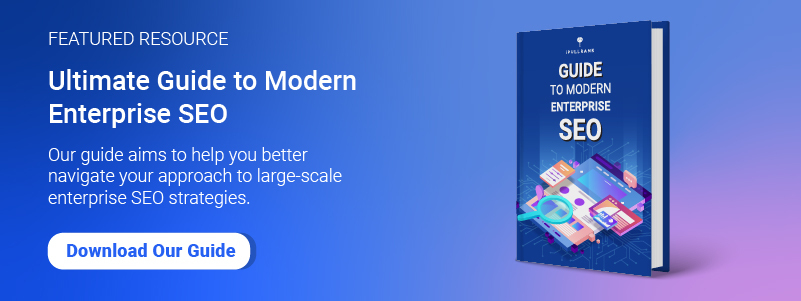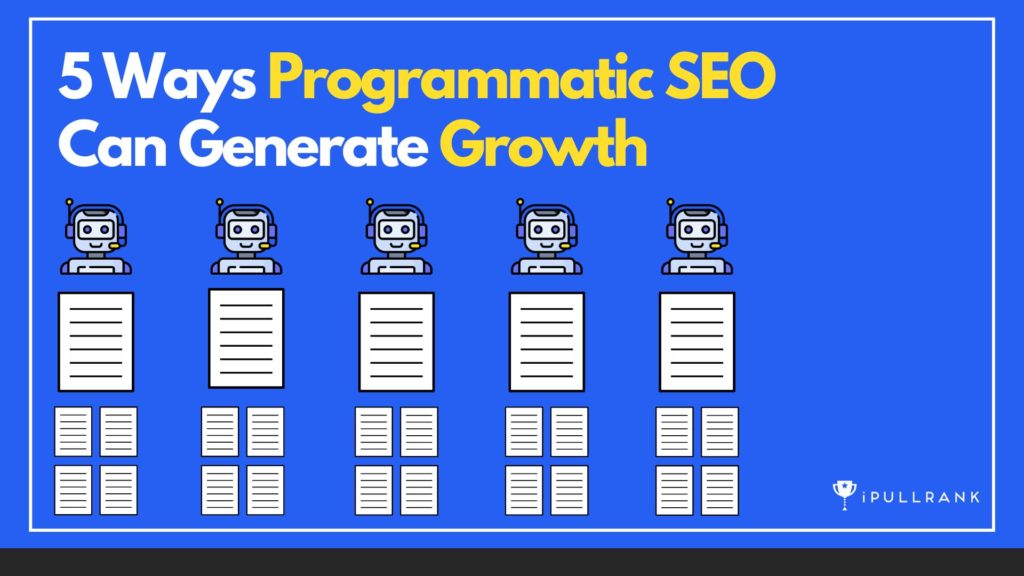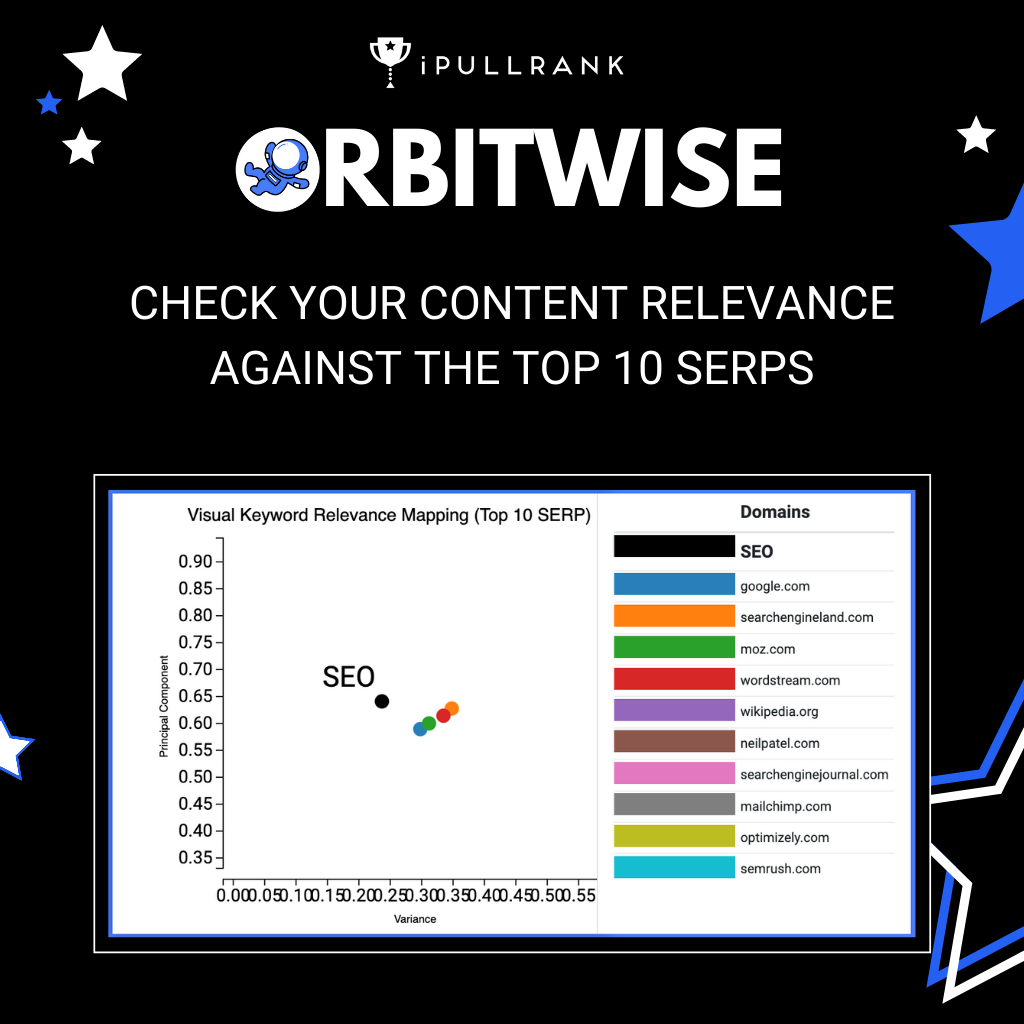Organic search is s-l-o-w.
Building content is slower. But it doesn’t have to be.
Ahrefs analyzed 2 million random keywords and found that 95% of newly published pages don’t make it into Google’s top ten.
Only 5.7% of web pages made it, but here’s the thing, it still took 2 to 6 months to achieve this rank.
Does SEO take 6 months? Here’s iPullRank’s Founder and CEO, Michael King explaining why it doesn’t.
Is there a way to deal with this? A way to successfully scale organic search, generating significant traffic via the low-hanging fruit most people ignore? As a matter of fact, there is.
Today we’re going to look at Programmatic SEO.
Programmatic SEO belongs in the trash
This is bad. Programmatic SEO is the new doorway page, right? Doesn’t Google frown on this sort of thing?
Not at all.
Here’s how Google describes doorway pages on Search Central.
“Doorways are sites or pages created to rank for specific, similar search queries. They are bad for users because they can lead to multiple similar pages in search results, where each result takes the user to essentially the same destination. They can also lead users to intermediate pages that are less useful than the final destination.
Here are some examples of doorways:
- Having multiple domain names or pages targeted at specific regions or cities that funnel users to one page
- Pages generated to funnel visitors into the actual usable or relevant portion of your site(s)
- Substantially similar pages that are closer to search results than a clearly defined, browseable hierarchy.”
Okay, what is Programmatic SEO?
Programmatic SEO refers to code-generated web pages that produce a large number of specialized content using data pulled from your database. It’s designed to address a specific searcher’s need and works well with lots of long-tail, niche, or low-traffic keywords.
With Programmatic search, brands start with a template, optimize their pages around specific keywords, and pull data from their database that best matches searcher intent. The standard approach is manual content production targeting high-volume keywords; pages are painstakingly written one page at a time. Doing this allows brands to create truly useful content at scale in a way that outpaces the slow and steady pace of traditional content development; both approaches are necessary.
Remember, the focus here is being useful.
Here’s another bit of great news. If you’re an enterprise, Google has a soft spot for you. Remember that Google’s former Chief Executive said, “Brands are the solution, not the problem. That’s how you organize the cesspool. In a world of no constraints, where anyone can publish anything, brand affinity is clearly high-wired. It’s so fundamental to human existence it’s not going to go away. How else would you organize society?”
What does this mean?
Google looks to large, established, enterprise brands like yours to organize their search results. If you’re following their guidelines and your campaign is in the right hands, Programmatic SEO is an obvious slam dunk.
Why your brand needs Programmatic SEO
Programmatic SEO offers significant benefits for brands that, in our hypercompetitive environment, are no longer optional. This sounds a bit spammy; what kind of benefits are we talking about here?
- Lower costs-per-content: Since your content is developed programmatically, production costs will be much lower than manual content. It obviously won’t be as detailed as the manual content pieces you create, so it may make sense to work with your content team to spruce up programmatic content pages on an as-needed basis.
- Scalability: With Programmatic SEO, you can rapidly create thousands of useful, high-value web pages. Handled properly, these web pages will deliver traffic and conversions over a large and broad set of keywords.
- Extended reach: Instead of focusing on a core list of 300 – 1,000 high-traffic keywords, you can target 100,000+ long tail keywords across a broad variety of topics; Google’s happy so long as you’re creating valuable, high E-A-T content.
- Rapid results: Programmatic SEO can be scaled rapidly since the process is code driven rather than manual content creation. Brands are able to target more long-tail keywords that are less competitive and generate low but steady traffic.
- Greater conversions: Remember, you’re targeting massive keyword lists. Individually, these pages may not get a lot of traffic. It’s a different story once these pages are aggregated together (i.e., 100,000 keywords * 25 visits per keyword = 2,500,000 visits). If these programmatic pages are highly relevant (as they should be), you’ll find your conversion rate is higher.
- Scalable link building: Depending on the type of content – ego-bait, rich data, viral, reference – inbound links are easier to come by. Embed codes, badges, awards, or survey and test results are all scalable forms of programmatic link building.
This looks pretty great, right? There are automated, more efficient ways to get faster results from organic search?
Where do I sign-up?
Google is still looking for high E-A-T content. For Programmatic SEO to work, your content needs to be relevant, helpful, authoritative, and trustworthy.
NOTE: Are you offering high or low E-A-T content? Find out here.
Buuut there are risks.
If you’re unprepared, these challenges are a problem with Programmatic SEO.
- Poor indexation: Good site architecture and consistent internal links are must-haves. If these pages aren’t getting indexed by Google, they’re not going to rank. Notifying Google when you publish, using schema, sitemaps, and consistent link building (programmatic + manual) are important steps.
- Thin content: Programmatic pages have to be supremely useful to users. Google spells out its position on thin content pretty clearly. “Some site owners attempt to improve their pages’ ranking and attract visitors by creating pages with many words but little or no authentic content. Google will take action against domains that try to rank by just showing scraped or other cookie-cutter pages that don’t add substantial value to users.” This means penalties if generic content is being used to rank.
- Duplicate content: If you’re creating content similar to the content you’ve created programmatically, you’ll want to specify which version is canonical. There are many legitimate reasons for duplicate content (e.g., pages for multiple device types, dynamic URLs, HTTP vs. HTTPS). You’ll need to inspect your programmatically created pages to verify that this isn’t an issue and avoid penalties.
- Keyword cannibalization: When several pages on your website focus on the same target keywords, you create unnecessary competition. When your web pages compete against each other, you diminish your site’s organic reach/performance overall. As a result, none of these pages achieve their true potential.
- Crawl budget woes: How many links will Google crawl on your website? They don’t share these details with us, so it’s difficult to know. This means you’ll need to ensure that your site’s important pages are indexed first. Prioritize your pages accordingly, so Googlebot crawls your pages, but ensure you’re not flooding Google with pages.
These challenges can obviously be addressed, but it’s crucial that you begin with the end in mind. It’s much more cost-effective to prepare for these issues at the start of the campaign, during the research phase. Dealing with these issues after launching your campaign and publishing your pages is an absolute disaster in the making.
It’s easy to avoid with good planning.
What you’ll need to launch your Programmatic SEO campaign
The items you’ll need for your campaign are pretty straightforward. They are as follows:
1. Your keyword list + keyword intent
You’ll want to start with a list of keywords (head terms are best). There are many ways to do this, but one of my favorites begins with a wonderful tool called The Permutator. You can use your keyword tool of choice (e.g., Semrush, Ahrefs) to create a seed list of keywords.
Using The Permutator, you can turn your seed list of 2,000 keywords into a massive long tail list of 100,000+ keywords in a relatively short amount of time.
Let’s pretend we’ve decided to take the programmatic approach Fed recommends.
The programmatic SEO approach would be to make individual web pages targeting the following search query patterns:
— Fed 🐻 (@foliofed) May 1, 2022
{{country}} weather
{{city}} weather
{{city}} weather in {{month}}
weather tomorrow in {{city}}
10-day {{city}} weather
hourly weather in {{city}}
If we’re following the format he’s used, our list of seed keywords might look like this.
- {{country}} weather
- {{country}} 5-day forecast
- {{country}} 5 day forecast
- {{country}} 10-day forecast
- {{country}} 10 day forecast
- {{city}} weather
- {{city}} weather in {{month}}
- {{city}} {{state}} weather
- {{city}} {{state}} 5-day forecast
- {{city}} {{state}} 5 day forecast
- {{city}} {{state}} 10-day forecast
- {{city}} {{state}} 10 day forecast
- weather tomorrow in {{city}}
- 5-day {{city}} weather
- 10-day {{city}} weather
- 5 day {{city}} weather
- 10 day {{city}} weather
- 5-day forecast {{city}} {{state}}
- 5 day forecast {{city}} {{state}}
- 10-day forecast {{city}} {{state}}
- 10 day forecast {{city}} {{state}}
- hourly weather in {{city}}
- Temp in {{city}} now
- Temp in {{city}} {{state}} now
- Temp in {{city}} {{state}} 5 days
- Temp in {{city}} {{state}} 5-days
- Temp in {{city}} {{state}} 10-days
- Temp in {{city}} {{state}} 10 days
Look for synonyms, plurals, prefixes, suffixes, and modifiers.
You see where I’m going with this, right?
For this particular list of keywords, you will need a list of countries, cities, and states/provinces in the areas you’re targeting via search. You will need a list of the various permutations people use in their queries. You can grab this data from Semrush or Ahrefs, then plug it into The Permutator to rapidly expand your keyword list. Then, take that list, and plug it back into Semrush or Ahrefs to identify your high, medium, and low traffic keywords.
A list of 100,000+ keywords in minutes.
All set? Excellent.
Next, you’ll need to identify the searcher intent. When searchers enter these queries in Google, what specifically are they looking for? Do they know what they want? What do searchers want to see first? Are they looking for a quick, instant answer so they can leave your site, or are they looking for detailed information?
You’ll need to (a.) ask the right questions and (b.) present answers to those questions.
2. Your value proposition
Searchers will arrive on site with three specific questions. (1.) Where am I (2.) What can I do here, (3.) why should I do it? Your value proposition should answer these three questions in a matter of seconds for your searchers.
The value proposition of these pages should be front and center. It should match the searcher’s intent, attract and hold their attention, and answer the three questions listed above. We’ll take a closer look at this later on.
3. Competitor research
What are your competitors doing? Are there gaps in their offer? Is their value proposition lacking? Collectively, who are the top five leaders in Google’s search results? Where are they stronger? Weaker?
How many inbound links do they have? Are they using Programmatic SEO data? How much of a headstart do they have? What will it cost to catch and pass these competitors? Is it a good idea (financially) to do so? Who should you pursue first?
Questions are the foundation of good research.
The better your questions, the better your answers, and the easier it is to attract and hold searcher attention. Look for the keywords your competitors are using and where they focus. Treat your competitor analysis as a kind of discovery you can use to help expand your list.
How do you do that?
- Step 1: Use competitor ads to identify keyword themes, ad groups, and your competitors’ campaigns. This will give you a macro-level view of the keywords competitors are targeting and give you the direction you need to expand your keyword list (using The Permutator).
- Step 2: Segment your keywords to identify queries shared by you and your competitors, keywords where you have stronger/weaker rankings, missing keywords (ones your competitors have that you don’t), and dominant keywords (you have keywords that your competitors don’t).
- Step 3: Analyze their value proposition. Are there specific areas where you can create a stronger, more irresistible offer to searchers? Is their offers/web pages in-line with searcher intent? Are yours in line?
- Step 4: Work to identify conversion keywords. Again, tools like Semrush and Ahrefs are invaluable here. Use these tools to identify keywords that are performing well for your competitors. If you’re running Google Ads, you’ll want to get this data from your search teams as well.
This data gives you direction, and it helps you to set goals.
4. Valuable content
Your competitor research should give you a clear idea of the content searchers want, the content that leads to a conversion, how to connect the various types of queries and pages together, and how to create a cohesive plan that moves searchers from prospects to buyers.
What exactly is ‘valuable content?’
Google tells us. According to Google, “The Helpful Content update aims to better reward content where visitors feel they’ve had a satisfying experience, while content that doesn’t meet a visitor’s expectations won’t perform as well….”
Google wants you to “follow our long-standing advice and guidelines to create content for people, not for search engines. People-first content creators focus first on creating satisfying content, while also utilizing SEO best practices to bring searchers additional value.”
See our guide for more information on Google’s Helpful Content Update.
5. Your data source
Your data can come from various places, but it’s necessary to establish this ahead of time as this is the cornerstone of programmatic search. Here are a few of the sources you may need.
- Internal data derived from internal primary sources (i.e., the location, number, and citation data for each of your retail stores)
- Third-party APIs that provide you with the appropriate level of access
- Collected data sourced from researchers who are responsible for the data collection, data entry, and formatting – ensuring that your content is available and ready to use
- Open datasets like the ones listed at freecodecamp
The possibilities for this data are endless. You can mix and match sources to create new and original data and content, aggregate content from specific sources, focusing on a particular topic. You can use one data source to provide updates or supplemental information for another data source, or you can use your data to gain access to deeper, more in-depth data from secondary and tertiary sources.
The possibilities are incredible.
6. Template(s) for your web pages
You’ll need an SEO-friendly, well-designed template that has all of the important on-page factors baked in. You’re looking to create content from your data source; you’ll want to ensure that your template’s UX and CX elements are adequately planned for.
Your HTML template should:
- Be well-designed and appealing
- Be grammatically sound
- Have the right CX or UX elements (e.g., site architecture, support and contact info, supplemental information, FAQs, etc.)
- Include social proof elements (e.g., phone number, reviews, testimonials, case studies, samples, live chat links, etc.)
- Be SEO-friendly, accounting for all on-page factors relevant to each page. It goes without saying that these elements should be unique/relevant to each page that’s programmatically created.
To quote FolioFed, “The HTML template gets rendered with your data. Everything necessary for displaying the page should be in your template, or in your data source.
This includes:
- The “meat” of your content
- Page headers
- Meta tags
- Images
- Links to other pages”
These are the ingredients you’ll need to create and implement your own Programmatic SEO campaign.
5 Use Cases of Programmatic SEO
Let’s take a look at some use cases and examples of Programmatic SEO in action.
1. Local SEO Location Pages
Using Programmatic SEO, you can create a large list of custom pages that provide essential information for customers. There are quite a few enterprises that use this strategy, but many of them offer generic content that’s not all that helpful.
And then there’s Home Depot.
Take a look.
Home Depot does a beautiful job of this. Using Programmatic SEO, they create pages that automatically include the following details:
- The name of the store and store number (Northlake #1919)
- They aggregate and share first-party reviews for each location, creating unique and very valuable content
- Contact information for the store
- Hours of operation (which varies by location)
- The address
- Curbside pickup requests
- Features and amenities specific to this store (Northlake)
- Specials, discounts, and deals that are specific to this store (incentivizing shoppers to browse and shop)
- Nearby stores (useful in the event that this particular store is out of a specific product)
- Trending items in the neighborhood (incredibly useful when you’re searching for a snowblower or sump pump and every other store is sold out)
- A breakdown of store-specific features and amenities
- An FAQ with common questions
This is beautiful.
In a few clicks, I’ve learned a tremendous amount of detail about the Home Depot store in my area. I immediately have useful information that tells me whether I can get what I need at this location or if I’m wasting my time.
This is outstanding work by Home Depot and a huge win for searchers, especially compared to competitors like Lowes or Menards.
Keywords include:
- Home Depot near me
- Home Depot {{zip code}}
- Home Depot {{city}}
- Home Depot {{city}} {{state}}
Home improvement stores near me
2. Travel and Hospitality
Let’s say I’m interested in traveling to Austin, Texas, for an event.
I’ve never been there.
I want to go out with family and friends after my event is finished, but I’m not sure what’s available in the area. That’s okay; I head to Google and enter the following query.
Top 10 things to do in Austin TX
And I see this:
I click through, and I arrive on this TripAdvisor page.
TripAdvisor uses Programmatic SEO to generate this page about events in and around Austin, TX:
- They provide me with a list of things to do
- Ways to tour the city (if I’m into that sort of thing); each listing has reviews
- A list of cultural tours
- Top-rated attractions in the city
- Wine, food, and nightlife spots
- Outdoor activities
- A list of events for day trips
- Art tours
- Customer reviews for each business or event listed on their site
- An FAQ with common questions
If I’m looking for a great time (and I am), TripAdvisor makes it easy to find city hotspots in and around Austin.
Keywords include:
- {{Top}} {{##}} things to do in {{city}}
- {{Top}} {{##}} things to do in {{zipcode}}
- {{Top}} Events near {{city}}
- {{Best}} events near {{city}}
- {{Top}} Events near {{zipcode}}
- {{Best}} events near {{zipcode}}
3. Long Tail Content
When it comes to content, Payscale used to lag behind Salary.com. That’s no longer the case today; Payscale has developed a competitive content strategy using its internal data to rank in Google, attract searchers, and drive traffic.
A quick search using the query “FBI Agent Salary.”
It brings up the following:
When I click through to Payscale’s landing page, I see this:
This is really helpful content that’s pulled from their user profile data. It’s visually appealing, easy to digest, and comprehensive.
- They lead with the salary, so I get an immediate answer to my question
- A salary range that shows the low, medium, and high end of the pay scale
- Numbers on bonuses, profit sharing, or commissions
- A free tool that provides a personalized report on your market worth for your area and personal details
- Data on the pay by experience level for FBI agents
- A job description outlining the roles and responsibilities for this position
- Reviews outlining how FBI agents rate their jobs and job satisfaction
- The benefits mix for this position (e.g., medical, dental, vision)
- Gender breakdowns for this position
- Career paths for an FBI agent
- FAQs with common questions about this role
- Popular employers for this position (in this example, there’s only one) and related jobs
- Popular skills and necessary skills for this role
In just a few seconds, I can get a clean snapshot of this position, the benefits, the skills needed, and even the career path I’d need to take to improve my chances of winning a position with the FBI.
This is comprehensive and helpful stuff.
It’s also data that’s relatively easy to generate programmatically.
Keywords include:
- {{title}} salary near {{city}}
- {{title}} salary near {{city}}, {{state}}
- {{title}} requirements
- {{title}} salary per week
- {{title}} salary reddit
- {{title}} salary
- {{title}} salary {{state}}
- what do {{title}} do
4. Ecommerce
Amazon is the 800 lbs. gorilla in the room.
They provide shoppers with a firehose of content they can use to make an informed decision. Just how helpful is this, though?
Let’s say I’m a shopper in the market for a new dashcam. I head over to Google, and I enter the following query.
best car camera front and rear
I see Amazon’s listing in Google, so I click through and arrive on this page.
See that?
This is Amazon’s best seller’s list for the exact type of product I’m looking at. Amazon puts the data from their product pages to work here. They give us a treasure trove of information we can use in tiny, bite-size pieces.
- Amazon uses simple criteria for these lists. “Our most popular products based on sales. Updated hourly.”
- Each of these products is numbered based on popularity
- Reviews for each product are showcased with each listing. What’s interesting about this is the bestsellers don’t always have the best reviews (#6 has more reviews and a better aggregate rating than #3)
- Each page lists the top 50 products in its category, and Amazon showcases and updates (hourly) each category. This is valuable data you can’t buy, and it’s based on real customers and actual sales (rather than a blogger review).
- Amazon also includes personalized products at the bottom of the page with a list of products you may be interested in.
This is outstanding.
Amazon does this with specialty pages (like these), product, and category pages. It’s a helpful and straightforward way to provide shoppers with the content they need to spend more.
Keywords include:
- {{brand}} dash cam
- {{brand}} dash camera
- {{brand}} dash camera {{under $100}}
- {{best}} {{wireless}} dash cam
- {{best}} {{wireless}} dash cam
- {{best}} {{wireless}} dash cam {{under $100}}
- {{best}} {{wired}} dash cam {{front and rear}}
- {{best}} {{wired}} dash cam {{front and rear}}
- {{best}} {{wired}} dash cam {{front and rear}} {{under $100}}
- {{best}} dash cam
- {{best}} dash cam {{under $100}}
- car dash camera {{front and rear}}
- {{best}} {{front and rear}} dash cam {{2022}}
- {{best}} dash cam {{2022}}
- {{brand}} dash cam {{front and rear}}
- {{best}} dash cam {{under $100}}
5. Informational Content
For a long time, Buzzfeed was considered a joke.
Today, a rapidly growing number of people see Buzzfeed as a viable source of serious, hard-hitting news. How did they get there? They used a variety of strategies, including Programmatic Link Building. Yeah, I’m talking about those viral quizzes they created.
Don’t laugh.
This strategy is so effective for them that almost a million people took 19 quizzes in a month’s time. It’s working very well for them.
It’s classic ego bait.
You take the quiz and then brag about it to your friends or share it on your profile or website. Let’s take a look.
This ridiculous quiz has almost 500 inbound links.
It’s repeatedly shared on social media, gaining traction as more and more people take this quiz. It’s classic ego bait, and if what BuzzFeed said is true, they’re generating a ton of traffic using this programmatic approach. It’s a strategy used by large sources, including Time, The New York Times, Vox, and others.
It’s working.
What about using AI and NLG to generate pages automatically?
It’s scalable content.
Brands can rapidly generate massive amounts of content on any given topic if it works. That’s a huge win for brands, right? What could be better? Super smart computers are churning out massive amounts of high-quality content.
We’re not there yet.
According to Google’s Search Advocate, John Mueller, content that’s auto-generated with AI is considered spam and a violation of Google’s Webmaster Guidelines.
Mueller elaborates on this, stating:
“For us, these would, essentially, still fall into the category of automatically generated content which is something we’ve had in the Webmaster Guidelines since almost the beginning.
And people have been automatically generating content in lots of different ways. And for us, if you’re using machine learning tools to generate your content, it’s essentially the same as if you’re just shuffling words around, or looking up synonyms, or doing the translation tricks that people used to do. Those kind of things.
My suspicion is maybe the quality of content is a little bit better than the really old-school tools, but for us, it’s still automatically generated content, and that means for us it’s still against the Webmaster Guidelines. So we would consider that to be spam.”
Can Google tell the difference between AI-generated content and the real thing?
Check out Rob Lennon’s hot takes on AI content when he was interviewed on Rankable..
They’re not saying.
What Mueller does say, is that you’ll likely receive a manual penalty if you’re caught. It doesn’t seem like it’s worth the risk.
What about Natural Language Generation (NLG)?
It’s a promising advance, but it still requires significant human oversight. Kelsey Jones explains in her post.
“AI still cannot write like a human can; the content creation process requires humans to grow, improve, and review content written with NLG. We still need some serious oversight and quality assurance.”
It does have its uses, though.
Use it to create blog post title ideas, meta descriptions, and outlines. Analyze your competitors and use it to assist with content repurposing, but don’t use it to create massive amounts of content. We’ll get there one day, but for now, NLG still requires significant oversight from real people.
Programmatic SEO amplifies the impact of your organic search campaigns
Traditional organic search takes time.
Manually creating content is a necessary part of the SEO game, but it’s not the only game in town.
Programmatic SEO offers significant benefits for brands that, in our hypercompetitive environment, are no longer optional. You can get lower costs-per-content, scalability, extended reach, more conversions at a reduced cost, and scalable link building. Programmatic search is an essential part of the Enterprise SEO toolkit. The important question here is whether it’s in your toolbox.

- The Cost of SEO Services in 2024 - January 4, 2024
- The 2024 SEO Guide To Successful Website Migration - April 4, 2023
- How Audience Research Shapes Financial Services Marketing - February 16, 2023











Leave a Comment